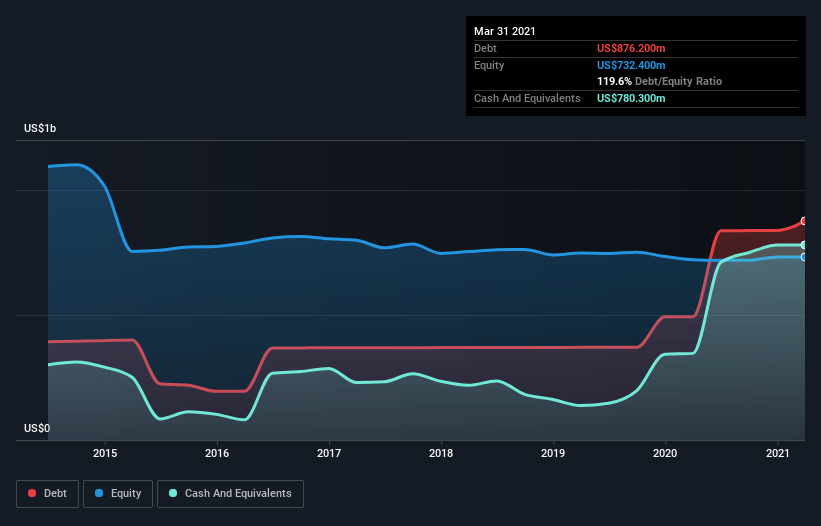- United States
- /
- Metals and Mining
- /
- NasdaqGS:KALU
Kaiser Aluminum (NASDAQ:KALU) Seems To Use Debt Quite Sensibly

Warren Buffett famously said, 'Volatility is far from synonymous with risk.' It's only natural to consider a company's balance sheet when you examine how risky it is, since debt is often involved when a business collapses. Importantly, Kaiser Aluminum Corporation (NASDAQ:KALU) does carry debt. But is this debt a concern to shareholders?
What Risk Does Debt Bring?
Debt is a tool to help businesses grow, but if a business is incapable of paying off its lenders, then it exists at their mercy. If things get really bad, the lenders can take control of the business. However, a more usual (but still expensive) situation is where a company must dilute shareholders at a cheap share price simply to get debt under control. By replacing dilution, though, debt can be an extremely good tool for businesses that need capital to invest in growth at high rates of return. The first step when considering a company's debt levels is to consider its cash and debt together.
View our latest analysis for Kaiser Aluminum
How Much Debt Does Kaiser Aluminum Carry?
You can click the graphic below for the historical numbers, but it shows that as of December 2020 Kaiser Aluminum had US$838.1m of debt, an increase on US$492.8m, over one year. However, it does have US$780.3m in cash offsetting this, leading to net debt of about US$57.8m.

A Look At Kaiser Aluminum's Liabilities
The latest balance sheet data shows that Kaiser Aluminum had liabilities of US$158.3m due within a year, and liabilities of US$974.0m falling due after that. On the other hand, it had cash of US$780.3m and US$160.5m worth of receivables due within a year. So its liabilities total US$191.5m more than the combination of its cash and short-term receivables.
Of course, Kaiser Aluminum has a market capitalization of US$2.15b, so these liabilities are probably manageable. However, we do think it is worth keeping an eye on its balance sheet strength, as it may change over time.
In order to size up a company's debt relative to its earnings, we calculate its net debt divided by its earnings before interest, tax, depreciation, and amortization (EBITDA) and its earnings before interest and tax (EBIT) divided by its interest expense (its interest cover). The advantage of this approach is that we take into account both the absolute quantum of debt (with net debt to EBITDA) and the actual interest expenses associated with that debt (with its interest cover ratio).
Given net debt is only 0.51 times EBITDA, it is initially surprising to see that Kaiser Aluminum's EBIT has low interest coverage of 1.3 times. So one way or the other, it's clear the debt levels are not trivial. Importantly, Kaiser Aluminum's EBIT fell a jaw-dropping 59% in the last twelve months. If that earnings trend continues then paying off its debt will be about as easy as herding cats on to a roller coaster. The balance sheet is clearly the area to focus on when you are analysing debt. But ultimately the future profitability of the business will decide if Kaiser Aluminum can strengthen its balance sheet over time. So if you're focused on the future you can check out this free report showing analyst profit forecasts.
Finally, a business needs free cash flow to pay off debt; accounting profits just don't cut it. So we always check how much of that EBIT is translated into free cash flow. Over the last three years, Kaiser Aluminum actually produced more free cash flow than EBIT. There's nothing better than incoming cash when it comes to staying in your lenders' good graces.
Our View
Kaiser Aluminum's EBIT growth rate was a real negative on this analysis, as was its interest cover. But like a ballerina ending on a perfect pirouette, it has not trouble converting EBIT to free cash flow. Looking at all this data makes us feel a little cautious about Kaiser Aluminum's debt levels. While we appreciate debt can enhance returns on equity, we'd suggest that shareholders keep close watch on its debt levels, lest they increase. There's no doubt that we learn most about debt from the balance sheet. But ultimately, every company can contain risks that exist outside of the balance sheet. To that end, you should learn about the 6 warning signs we've spotted with Kaiser Aluminum (including 1 which is concerning) .
When all is said and done, sometimes its easier to focus on companies that don't even need debt. Readers can access a list of growth stocks with zero net debt 100% free, right now.
When trading Kaiser Aluminum or any other investment, use the platform considered by many to be the Professional's Gateway to the Worlds Market, Interactive Brokers. You get the lowest-cost* trading on stocks, options, futures, forex, bonds and funds worldwide from a single integrated account. Promoted
Valuation is complex, but we're here to simplify it.
Discover if Kaiser Aluminum might be undervalued or overvalued with our detailed analysis, featuring fair value estimates, potential risks, dividends, insider trades, and its financial condition.
Access Free AnalysisThis article by Simply Wall St is general in nature. It does not constitute a recommendation to buy or sell any stock, and does not take account of your objectives, or your financial situation. We aim to bring you long-term focused analysis driven by fundamental data. Note that our analysis may not factor in the latest price-sensitive company announcements or qualitative material. Simply Wall St has no position in any stocks mentioned.
*Interactive Brokers Rated Lowest Cost Broker by StockBrokers.com Annual Online Review 2020
Have feedback on this article? Concerned about the content? Get in touch with us directly. Alternatively, email editorial-team (at) simplywallst.com.
About NasdaqGS:KALU
Kaiser Aluminum
Manufactures and sells semi-fabricated specialty aluminum mill products.
Proven track record and fair value.
Similar Companies
Market Insights
Community Narratives



